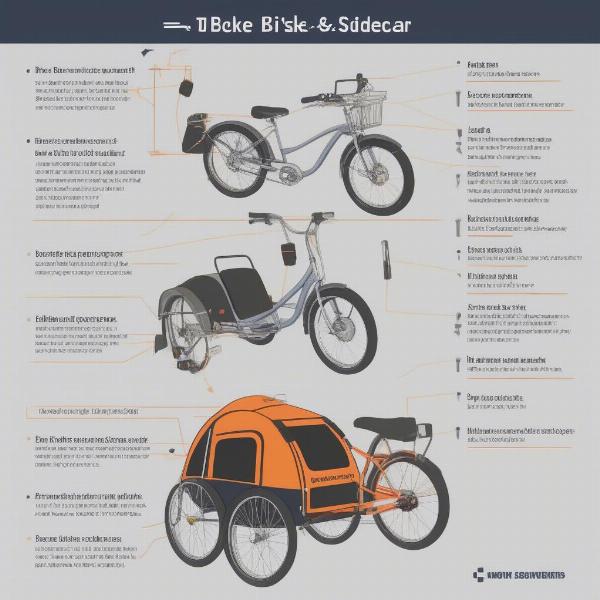Cycling with your furry friend can be a fantastic way to bond, exercise, and explore the world together. For dogs who may be too small, senior, or have certain health conditions that prevent them from running alongside your bike, a dog bike sidecar offers a safe and comfortable alternative. This guide explores everything you need to know about bike with dog sidecar, from choosing the right one to ensuring a safe and enjoyable experience for both you and your pup.
Choosing the Perfect Dog Bike Sidecar
Selecting the right sidecar depends on your dog’s size, weight, and temperament. Consider these factors:
- Size and Weight Capacity: Ensure the sidecar is spacious enough for your dog to sit, stand, and turn around comfortably. Check the weight limit to ensure it can safely accommodate your dog.
- Material and Construction: Look for sturdy, weather-resistant materials like steel or aluminum frames with durable fabric coverings.
- Safety Features: A secure harness system inside the sidecar is essential to prevent your dog from jumping out. Reflective strips and safety flags enhance visibility.
- Entry and Exit: Choose a sidecar with easy access for your dog, preferably with a ramp or low entry point.
- Suspension: A sidecar with suspension provides a smoother ride for your dog, especially on bumpy terrain.
 Choosing the Right Dog Bike Sidecar
Choosing the Right Dog Bike Sidecar
Getting Your Dog Used to the Sidecar
Introducing your dog to the sidecar should be a gradual process:
- Start with Positive Associations: Let your dog sniff and explore the sidecar without attaching it to the bike. Place treats and toys inside to create a positive connection.
- Short Rides: Begin with short, slow rides around your yard or a quiet area. Gradually increase the distance and duration as your dog becomes more comfortable.
- Positive Reinforcement: Reward your dog with praise and treats throughout the process.
- Safety First: Always use a harness to secure your dog inside the sidecar. Never leave your dog unattended in the sidecar.
Safety Tips for Cycling with a Dog Sidecar
- Start Slow: Gradually increase your speed and distance as your dog adjusts to the sidecar.
- Avoid Sudden Turns and Stops: These can cause your dog to become disoriented or injured.
- Check the Weather: Avoid cycling in extreme heat or cold.
- Hydration: Bring water for your dog, especially on longer rides.
- Regular Breaks: Stop frequently to allow your dog to stretch their legs and relieve themselves.
- Be Aware of Traffic: Be extra cautious when cycling near traffic.
Maintaining Your Dog Bike Sidecar
Regular maintenance will ensure the longevity of your sidecar:
- Clean Regularly: Wipe down the sidecar after each use to remove dirt and debris.
- Check for Damage: Inspect the frame, fabric, and attachments for any signs of wear and tear.
- Lubricate Moving Parts: Keep the wheels and other moving parts lubricated for smooth operation.
- Store Properly: Store the sidecar in a dry, protected area when not in use.
What if My Dog Doesn’t Like the Sidecar?
Not all dogs enjoy riding in a sidecar. If your dog shows signs of anxiety or distress, don’t force them. Try alternative methods of exercise, such as walking or playing fetch. dog sidecar for bike Some dogs may simply need more time to acclimate. Continue the introduction process slowly and patiently.
Conclusion
A dog bike sidecar opens up a world of opportunities for cycling adventures with your canine companion. dog bike sidecar By choosing the right sidecar, prioritizing safety, and introducing your dog gradually, you can create memorable experiences and strengthen your bond.
FAQs
- How much does a dog bike sidecar cost? The price varies depending on the size, features, and brand, typically ranging from $100 to $500.
- Can I use a dog bike sidecar with any bike? Most sidecars are designed to be compatible with a variety of bikes, but it’s essential to check compatibility before purchasing.
- Is it safe to cycle with a dog in a sidecar on busy roads? Extra caution is required when cycling with a dog in a sidecar on busy roads. Always be aware of traffic and use proper safety equipment. electric bike with sidecar for dog
- What age can a puppy ride in a bike sidecar? It’s best to wait until your puppy is at least six months old and has developed sufficient bone and muscle strength.
- Can I use a dog bike sidecar with a senior dog? A sidecar is an excellent option for senior dogs who can no longer run alongside a bike.
- How do I clean my dog bike sidecar? Most sidecars can be cleaned with soap and water.
- Where can I buy a dog bike sidecar? Dog bike sidecars can be purchased at pet stores, bike shops, and online retailers. bike sidecar dog
ILM Dog is your one-stop resource for expert advice on dog breeds, health, training, nutrition, grooming, and much more. We offer valuable insights to help you provide the best possible care for your furry friend. Whether you’re looking for guidance on choosing the right breed or need help with training and behavior, ILM Dog has you covered. Contact us at [email protected] or +44 20-3965-8624 for personalized support. Visit us at ILM Dog today!